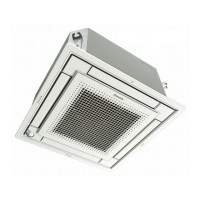
Do you have a question about the Daikin FFQ09Q2VJUFFQ12Q2VJUFFQ15Q2VJUFFQ18Q2VJURX09QMVJURX12QMVJURX15QMVJURX18QMVJU and is the answer not in the manual?
| Brand | Daikin |
|---|---|
| Model | FFQ09Q2VJUFFQ12Q2VJUFFQ15Q2VJUFFQ18Q2VJURX09QMVJURX12QMVJURX15QMVJURX18QMVJU |
| Category | Air Conditioner |
| Language | English |
Lists and categorizes system functions.
Details technical specifications for indoor and outdoor units.
Wiring diagram for the indoor unit's control PCB and connectors.
Wiring diagram for the wired remote controller's PCB.
Wiring diagrams for transmitter and receiver boards.
Wiring diagrams for the outdoor unit's main PCB.
Safety warnings specifically for personnel performing work.
Safety warnings for end-users of the product.
Explains core operational functions of the air conditioner.
Details how the unit regulates room temperature.
Explains how compressor frequency is regulated.
Covers automatic swing and fixed airflow settings.
How to set indoor fan speed via remote.
Operation for dehumidification.
Steps to set the unit's clock.
Setting up timed operations.
Temperature adjustment for unoccupied periods.
Operation of the condensate drain system.
Prevents cold air blast during heating startup.
Features related to optional sensors.
Covers signal reception and auto-restart.
Technical parameters for control logic.
Hierarchy of system operation modes.
Details the wired remote controller's functions and display.
Common issues and initial checks.
Diagnosing issues based on LED indicators.
Troubleshooting indoor unit LED signals.
Troubleshooting outdoor unit LED indicators.
Procedures for diagnosing specific components.
Diagnosing issues via the wired remote.
Diagnosing issues via the wireless remote.
Detailed fault finding procedures.
List of error codes and their meanings.
Troubleshooting steps for indoor PCB faults.
Diagnosing drain system errors.
Troubleshooting indoor fan motor issues.
Diagnosing humidifier system faults.
Troubleshooting sensor (thermistor) errors.
Diagnosing errors related to optional sensors.
Troubleshooting remote controller sensor issues.
Diagnosing communication errors.
Diagnosing communication between multiple remotes.
Troubleshooting power supply voltage issues.
Diagnosing communication between indoor and outdoor units.
Troubleshooting unit compatibility issues.
Troubleshooting outdoor PCB faults.
Diagnosing compressor overload conditions.
Troubleshooting compressor lock faults.
Diagnosing outdoor fan motor lock.
Troubleshooting input overcurrent conditions.
Diagnosing four-way valve issues.
Troubleshooting discharge pipe temperature errors.
Troubleshooting high pressure conditions.
Diagnosing compressor temperature shutdown.
Troubleshooting compressor sensor faults.
Troubleshooting position sensor errors.
Troubleshooting outdoor unit thermistor errors.
Diagnosing electrical box temperature issues.
Troubleshooting radiation fin temperature issues.
Diagnosing output overcurrent conditions.
Procedures for checking specific components.
How to measure thermistor resistance.
Checking output signals from the fan motor connector.
Checking the quality of the power supply waveform.
Procedures to check the electronic expansion valve.
Evaluating the performance of the four-way valve.
Checking the refrigerant system of the inverter unit.
Using an inverter analyzer for diagnosis.
Checking rotation pulse signals on the outdoor PCB.
Verifying installation parameters.
Checking the system's discharge pressure.
Checking the outdoor fan's operation.
Checking for short circuits in the main circuit.
Procedures for checking the power module.
Procedure for safely handling refrigerant during relocation.
How to initiate cooling operation manually.
Steps for verifying system functionality after installation.
Configuring unit settings based on installation environment.
Step-by-step instructions for modifying field settings.
Summary of available field setting options.
Configuring multiple wired remotes for one unit.
Setting up wireless remotes and addresses.
Special setting for low-temperature cooling in facilities.
Proper application of thermal grease on replacement PCBs.
Visual representation of refrigerant piping.
Piping diagram for the indoor unit.
Piping diagrams for the outdoor unit.
Electrical connection diagrams.
Wiring diagram for the indoor unit.
Wiring diagrams for the outdoor unit.
Defines the operating boundaries of the system.